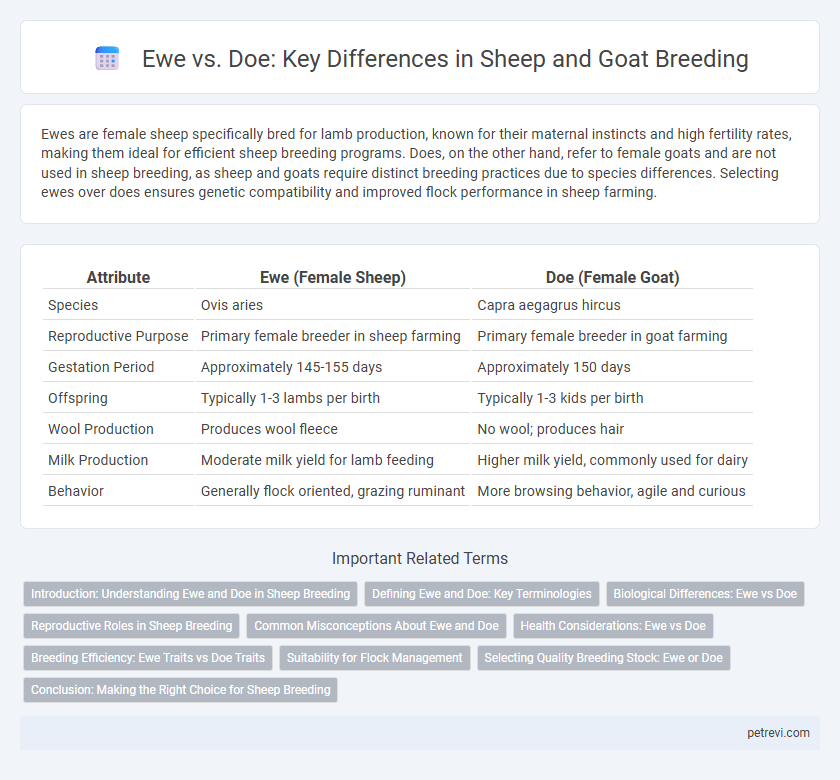Ewes are female sheep specifically bred for lamb production, known for their maternal instincts and high fertility rates, making them ideal for efficient sheep breeding programs. Does, on the other hand, refer to female goats and are not used in sheep breeding, as sheep and goats require distinct breeding practices due to species differences. Selecting ewes over does ensures genetic compatibility and improved flock performance in sheep farming.
Table of Comparison
| Attribute | Ewe (Female Sheep) | Doe (Female Goat) |
|---|---|---|
| Species | Ovis aries | Capra aegagrus hircus |
| Reproductive Purpose | Primary female breeder in sheep farming | Primary female breeder in goat farming |
| Gestation Period | Approximately 145-155 days | Approximately 150 days |
| Offspring | Typically 1-3 lambs per birth | Typically 1-3 kids per birth |
| Wool Production | Produces wool fleece | No wool; produces hair |
| Milk Production | Moderate milk yield for lamb feeding | Higher milk yield, commonly used for dairy |
| Behavior | Generally flock oriented, grazing ruminant | More browsing behavior, agile and curious |
Introduction: Understanding Ewe and Doe in Sheep Breeding
Ewe and doe refer to female animals used in breeding, but in sheep breeding, the term ewe specifically denotes a mature female sheep, while doe typically refers to female goats. Understanding the distinction between ewe and doe is crucial for effective livestock management and breeding strategies. Selecting the appropriate female species ensures optimal reproductive performance and flock health in sheep farming.
Defining Ewe and Doe: Key Terminologies
Ewe refers to a female sheep, a critical term in sheep breeding that distinguishes adult females from rams (males). Doe, while primarily used to describe female goats, is sometimes mistakenly applied to female sheep but is not accurate within sheep terminology. Understanding these key terms ensures precise communication in sheep breeding and management practices.
Biological Differences: Ewe vs Doe
Ewes and does exhibit distinct biological differences essential for sheep breeding, with ewes being female sheep and does being female goats. Ewes typically have a thicker wool coat adapted for colder climates, while does have hair or lighter coats suited to diverse environments. Reproductive cycles differ, as ewes are seasonal breeders with estrous cycles usually occurring in the fall, whereas does have more flexible breeding periods, often exhibiting estrus multiple times per year.
Reproductive Roles in Sheep Breeding
Ewes play a critical role in sheep breeding as the primary reproductive females responsible for gestation and lambing, producing offspring essential for flock expansion. In contrast, does refer to female goats and are not involved in sheep breeding, highlighting the importance of species-specific terminology for effective livestock management. Understanding the ewe's reproductive cycle, including estrus detection and lamb care, ensures optimal breeding outcomes and flock productivity.
Common Misconceptions About Ewe and Doe
Common misconceptions about ewe and doe center around their roles in breeding, often confusing their species-specific reproductive characteristics; ewes are female sheep essential for lamb production, while does are female goats involved in kid rearing. Ewe breeding cycles align with seasonal breeding patterns influenced by daylight, making them short-day breeders, whereas does can have more flexible breeding cycles depending on breed and management. Understanding the distinct physiological and behavioral traits of ewes and does prevents misapplication of breeding techniques and promotes effective livestock management.
Health Considerations: Ewe vs Doe
Ewes generally exhibit stronger resistance to common ovine diseases compared to does, making them a preferred choice for sheep breeding in terms of health resilience. Their robust immune systems reduce the frequency of infections such as foot rot and parasitic infestations, thereby lowering veterinary costs. Conversely, does may require more intensive health management to prevent respiratory and reproductive health issues, impacting overall breeding success.
Breeding Efficiency: Ewe Traits vs Doe Traits
Ewes exhibit superior breeding efficiency in sheep farming due to their strong maternal instincts, high lambing rates, and effective milk production, which ensures better lamb survival. Does, primarily related to goats, demonstrate different reproductive cycles and behavioral traits that are less optimal for sheep breeding purposes. Selecting ewes over does enhances flock productivity through traits like seasonal fertility and ease of lambing, critical for sustainable sheep breeding operations.
Suitability for Flock Management
Ewes are the preferred choice for sheep breeding due to their strong maternal instincts and high lambing rates, which enhance flock productivity and survival. Their ability to produce multiple offspring annually supports efficient genetic improvement and sustained flock growth. In contrast, does, typically referred to in goat breeding, lack the specific traits desirable for sheep flock management and breeding programs.
Selecting Quality Breeding Stock: Ewe or Doe
Selecting quality breeding stock in sheep farming hinges on choosing ewes over does, as ewes specifically refer to female sheep while does denote female goats. Ewes offer superior genetics for wool production, lambing rates, and meat quality, aligning with targeted sheep breeding goals. Understanding these species distinctions ensures precise breeding strategies and optimized flock improvement.
Conclusion: Making the Right Choice for Sheep Breeding
Selecting the ewe over the doe is crucial for optimizing genetics and reproductive success in sheep breeding due to the ewe's superior adaptability and maternal traits. Ewes exhibit enhanced fertility rates and better lambing outcomes compared to does, directly influencing flock productivity. Prioritizing ewes ensures improved flock health and economic returns in sheep farming operations.
Ewe vs Doe for Sheep Breeding Infographic

 petrevi.com
petrevi.com